新编实用英语综合教程unit1
- 格式:doc
- 大小:61.50 KB
- 文档页数:4
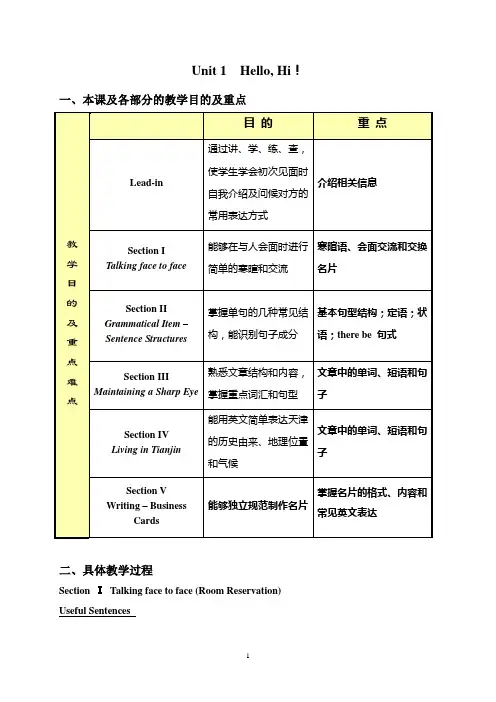
Unit 1 Hello, Hi!一、本课及各部分的教学目的及重点二、具体教学过程Section ⅠTalking face to face (Room Reservation) Useful Sentences(该环节首先播放教学视频,使学生对寒暄和交流过程有直接的认识。
然后教师将见面寒暄和交流的相关表达进行讲解后,学生自由模拟训练为主,重在帮助学生循序渐进地从单个句型到连贯对话进行过渡。
此时,教师不用对学生要求过高,可以先从模仿练起,鼓励学生举一反三。
)Section II Grammatical Item – Sentence Structures(句子结构)1.基本句型结构:(主+谓)结构、(主+谓+宾)结构、(主+谓+宾+宾补)结构、(主+系+表)结构(1)(主+谓)结构主谓结构的句子的谓语动词是不及物动词,后面不接宾语。
The sun rises. 太阳升起来了。
He died. 他死了。
She smiled. 她笑了。
(2)(主+谓+宾)结构主谓宾结构的谓语动词多数为及物动词,如果是不及物动词,需先加个介词,然后才可接宾语。
I love my hometown. 我爱我的家乡。
(及物动词)I dislike traveling. 我不喜欢旅游。
(及物动词)He is waiting for her. 他在等她。
(wait是不及物动词,后接for)(3)(主+谓+宾+宾)结构My father sent me a new bike as my birthday present. 我的爸爸送了我一辆新自行车作为生日礼物。
(me作间接宾语,bike作直接宾语)(4)(主+谓+宾+宾补)结构His words made me moved. 他的话叫我感动。
(过去分词作宾补)I find the novel very interesting. 我发现这部小说很有趣。
(现在分词作宾补)My manager asks me to do the work. 我的经理叫我做这项工作。
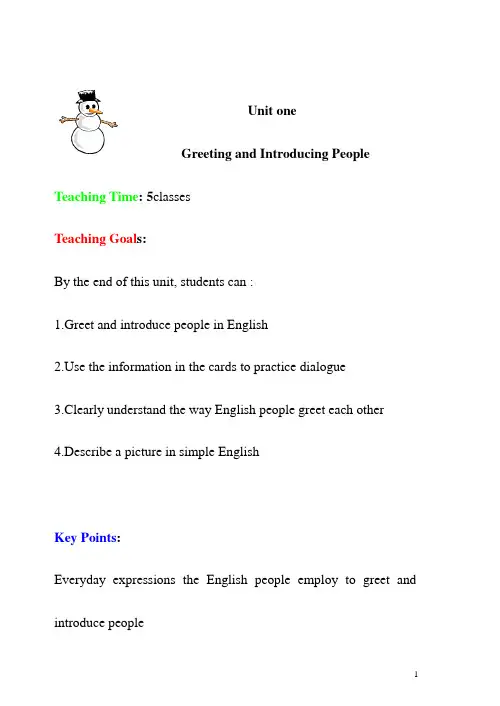
Unit oneGreeting and Introducing People Teaching Time: 5classesTeaching Goal s:By the end of this unit, students can :1.Greet and introduce people in Englishe the information in the cards to practice dialogue3.Clearly understand the way English people greet each other4.Describe a picture in simple EnglishKey Points:Everyday expressions the English people employ to greet and introduce people1st class: 50ms. Talking Face to FaceStep 1 . PresentationⅠ. Introducing myself according to my calling card: Good morning / afternoon, boys and girls! Nice to meet.Welcome to our college! My name is Yao fangfang . My English name is Yvonne. You can call me Mrs Yao or Yvonne as you like. From now on, we will be together through this term. I hope we can get well on with each other. I believe so! At last, I would like to give you my heartfelt wishes for you. May you have good study and campus life here.Ⅱ.Show them my calling card and explanation:first name/given name; (given at baptism)名last name/ family name:姓eg: Eliot T. SamuelⅢ.Give some useful expressions of greeting:A: Meeting people for the first timeHi / hello, nice to meet you. ( nice/glad/ honoured )Or:How do you do?How do you do?B: Meeting people againLong time no see/ how are you/ how have you been?It’s been quite a while, hasn’t it?How are you? Fine / nice/ pretty good/ not so bad/ just so so/ very well.That’s all right.How is your work / family?Ⅳ. Let students introduce themselves to me!Use the expression above.Step 2. Learn the samplesDialogue 1/ Dialogue 2.Ask students read them aloud and then practice them in pairs.Give some advice on how to learn English well.Four basic skills: Read, listening speaking and writing.Step 3. Act out ( homework)Look through and give the task to the students.Practice them in next class.Step 4 ..Homework: read aloud and learn by heart the “data bank”2nd class: Being All EarsKey language points1.leave a good impression upon sb.Your proper greeting leaves a good first impression upon me.2. rather3.each +V single4.that cool but inexperienced man5.I’ve got to6.speak of : mention7. nice to have met you.Step 1: Review check the homework. Act outStep 2. Listen to the dialogue and decode (twice)Step 3. Listen and respondListen to the dialogue again and answer the following questionsStep 4.Listen and completeNow listen to dialogue and complete the following sentences. Step 5. Listen and judge.Step 6.Read—listen—match and concludeMaterial: Introduction are important. P7Section Ⅲ( 3rd and 4th .5 classes) Maintaining a sharp eye Mr.: a courtesy title for any male adult not for styled sir”, “Dr”etc, used before the man’s family name or his position.b.Mrs.:“太太”a courtesy title for any married woman not styled“Lady”,“Dr.”etc.used before her husband’s .surname c.Ms.:“女士”a courtesy bile for a woman,whether she is married or not,followed by the family name.Miss:“小姐”A title to address an unmarried woman or a girl.It is followed by the family name.Miss can also be used as he title of address to an (esp.unknown)unmarrined woman. In this case,it is not followed by the name.l. Explanation of Difficult Sentences.1.(Title)The Way Americans GreetAnalysis:In this title,in which is omitted after the way> in…way means( to do sth ) by means of means a certain method美国人致意的方式Example:I think the way she runs her bookshop is worth studying.2. Speaking of time. I’ve got to run.A present participle clause used as an adverbial of cause/time. It means “ when it comes to time, I am reminded of…”说到时间,我得赶紧跑了。
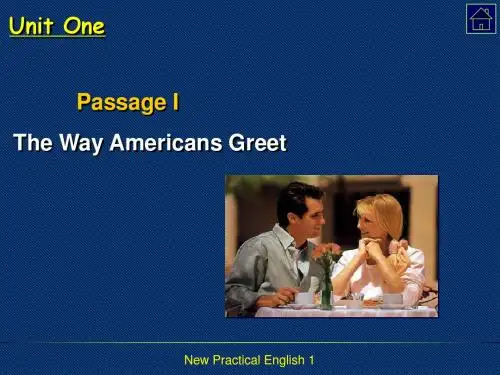
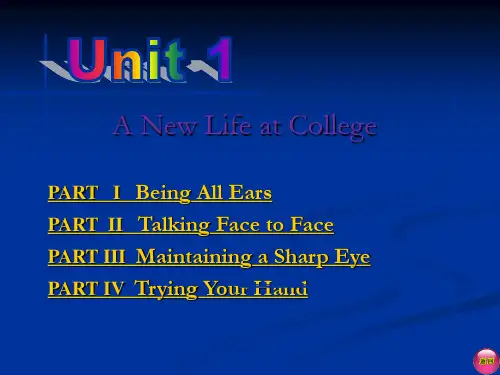
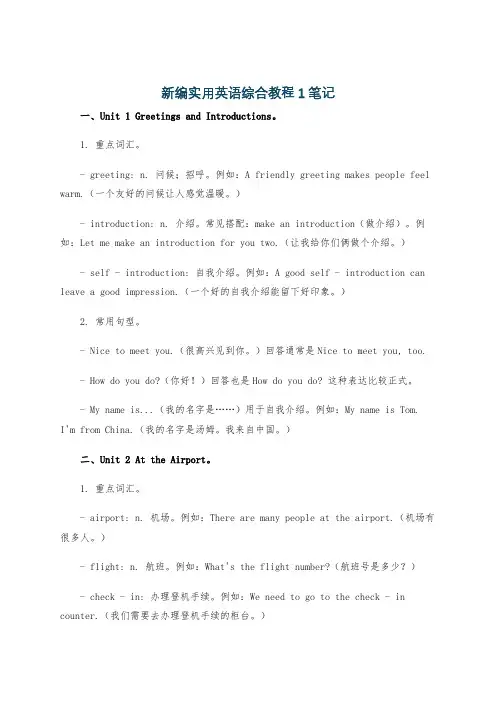
新编实用英语综合教程1笔记一、Unit 1 Greetings and Introductions。
1. 重点词汇。
- greeting: n. 问候;招呼。
例如:A friendly greeting makes people feel warm.(一个友好的问候让人感觉温暖。
)- introduction: n. 介绍。
常见搭配:make an introduction(做介绍)。
例如:Let me make an introduction for you two.(让我给你们俩做个介绍。
)- self - introduction: 自我介绍。
例如:A good self - introduction can leave a good impression.(一个好的自我介绍能留下好印象。
)2. 常用句型。
- Nice to meet you.(很高兴见到你。
)回答通常是Nice to meet you, too.- How do you do?(你好!)回答也是How do you do? 这种表达比较正式。
- My name is...(我的名字是……)用于自我介绍。
例如:My name is Tom.I'm from China.(我的名字是汤姆。
我来自中国。
)二、Unit 2 At the Airport。
1. 重点词汇。
- airport: n. 机场。
例如:There are many people at the airport.(机场有很多人。
)- flight: n. 航班。
例如:What's the flight number?(航班号是多少?)- check - in: 办理登机手续。
例如:We need to go to the check - in counter.(我们需要去办理登机手续的柜台。
)- boarding pass: 登机牌。
例如:Show your boarding pass before boarding.(登机前出示你的登机牌。
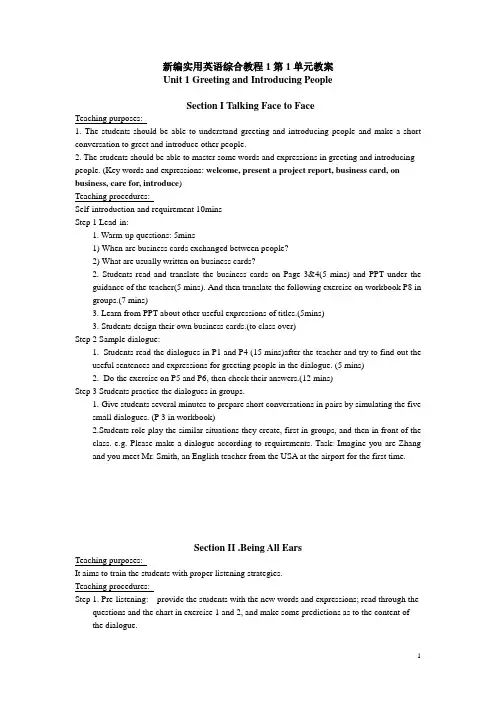
新编实用英语综合教程1第1单元教案Unit 1 Greeting and Introducing PeopleSection I Talking Face to FaceTeaching purposes:1. The students should be able to understand greeting and introducing people and make a short conversation to greet and introduce other people.2. The students should be able to master some words and expressions in greeting and introducing people. (Key words and expressions: welcome, present a project report, business card, on business, care for, introduce)Teaching procedures:Self-introduction and requirement 10minsStep 1 Lead-in:1. Warm-up questions: 5mins1) When are business cards exchanged between people?2) What are usually written on business cards?2. Students read and translate the business cards on Page 3&4(5 mins) and PPT under theguidance of the teacher(5 mins). And then translate the following exercise on workbook P8 in groups.(7 mins)3. Learn from PPT about other useful expressions of titles.(5mins)3. Students design their own business cards.(to class over)Step 2 Sample dialogue:1. Students read the dialogues in P1 and P4 (15 mins)after the teacher and try to find out theuseful sentences and expressions for greeting people in the dialogue. (5 mins)2. Do the exercise on P5 and P6, then check their answers.(12 mins)Step 3 Students practice the dialogues in groups.1.Give students several minutes to prepare short conversations in pairs by simulating the fivesmall dialogues. (P 3 in workbook)2.Students role-play the similar situations they create, first in groups, and then in front of theclass. e.g. Please make a dialogue according to requirements. Task: Imagine you are Zhang and you meet Mr. Smith, an English teacher from the USA at the airport for the first time.Section II .Being All EarsTeaching purposes:It aims to train the students with proper listening strategies.Teaching procedures:Step 1. Pre-listening: provide the students with the new words and expressions; read through the questions and the chart in exercise 1 and 2, and make some predictions as to the content of the dialogue.(Key words and expressions:1.Canada/The United States (of America) / the United Kingdom (of Great Britain andNorthern Ireland); England--Scotland--Welsh--Northern Ireland ;Britain;2.College3.Surprise surprise partyHis visit gave me a pleasant surprise. 他的来访使我感到惊喜。
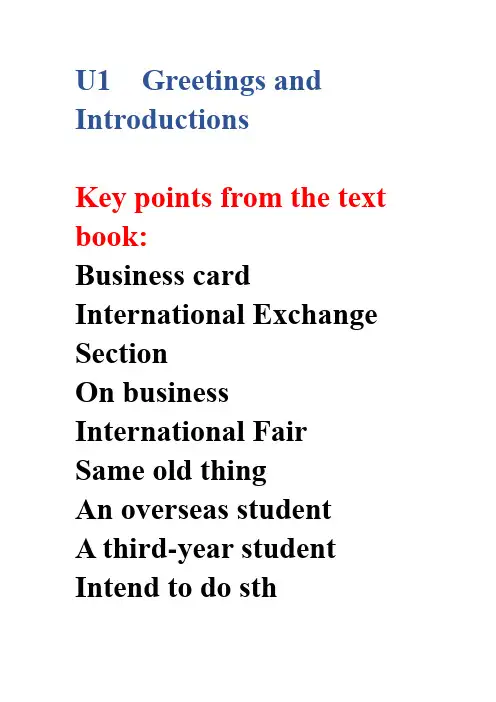
U1 Greetings and IntroductionsKey points from the text book:Business card International Exchange SectionOn business International Fair Same old thingAn overseas studentA third-year student Intend to do sthBachelor’s degree Master’s degree Doctor’s degreeFrom now onKeep in touch with sb At any timeBe of some helpSales clerkLeave a nice first impression upon Speaking of timeHave a quick look at sth Get toGet acquainted with sbDark brownChange one’s mind Under control Change intoBe born in spOn the top of my head Long time no see.Oh, it’s you.I’m here for the conference.Haven’t seen you for ages. What a pleasant surprise! What brings you here? Would you care for a drink?They introduce themselves to each other with pleasure.A proper introduction will leave a good first impression upon others.They prefer first names to formal titles in most cases. Such questions may be too personal to Europeans, but Americans do sometimes ask such questions.P10 NO.4: 1-8I try to be kind to other people, but sometimes I’m very stubborn and never change my mind.I like everything under control.I become a different person at home.Even though I enjoy working very hard each day at the university, I still feel that my family is more important than anything else.Key points from the blue book:Task2 & task7。
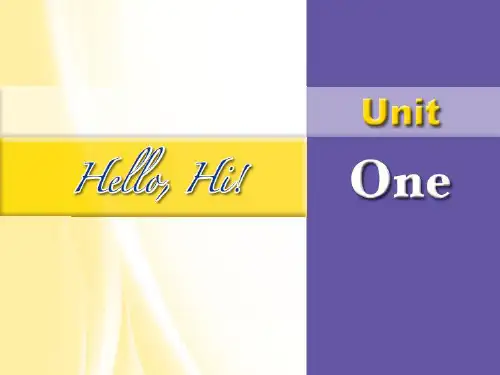
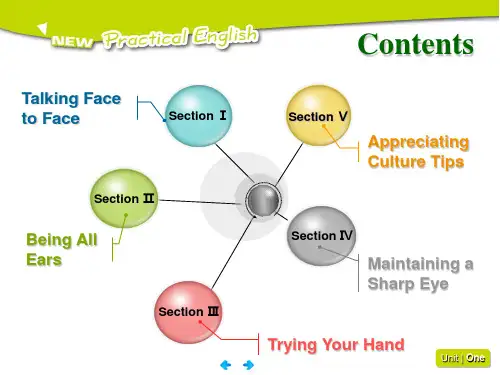


Unit1-Unit3 课文段落翻译1.第一册P16 Unit1 Passage1 第一段You, like most people, probably have been in such a situation where you are being asked for a business card, and while reaching for it ... and ... oops ... “I'm sorry, I must be out at the moment” or “they must be in my other bag” or “I left them at the office, I'm sorry,” and the conversation continues on with some sort of story about how this “never happens to me” or “I knew I was forgetting something this morning ...”像大多数人一样,你可能遇到过这样一种情况,你被要求要一张名片,而当你伸手去拿名片的时候,哎呀...“对不起,我现在一定是用完了”或者“他们一定在我其他包里”或者“我一定落在我的办公室里了,对不起”,并且对话会伴着这样的说辞继续下去“这种事情怎么才能不发生在我身上”或“我就知道今早上会忘点事情...”2.第一册P16 Unit1 Passage1 第二段Missed connections are missed opportunities for business. Business cards are a useful marketing tool, and an easy one to have with you at all times. Not having your cards can be seen as being unprepared to market yourself and your business. Don't start that new contact leaving them thinking “that person is already unprepared”.失去联系就是错失商机。
新编实用英语综合教程一重点单词Unit 1: Communication1. Communication - the act of sharing or exchanging information, ideas, or feelings through speech, writing, or other methods.2. Verbal - relating to or consisting of words, spoken or written.3. Nonverbal - not involving or using words; not able to speak.4. Gesture - a movement of part of the body, especially a hand or the head, to express an idea or meaning.5. Intonation - the rise and fall of the voice in speaking, giving meaning to words or sentences.6. Pronunciation - the way in which a word or language is spoken.7. Idiom - a group of words established by usage as having a meaning not deducible from those of the individual words (e.g., "kick the bucket" means to die).8. Slang - informal language that is more common in speech than in writing and typically restricted to a particular group of people.9. Jargon - special words or expressions used by a profession or group that are difficult for others to understand.10. Paraphrase - express the meaning of something using different words, especially to achieve greater clarity.11. Feedback - information about reactions to a product, a person's performance of a task, etc., used as a basis for improvement.12. Barriers - obstacles that prevent communication from being successful, such as language differences or cultural misunderstandings.Unit 2: Jobs and Careers1. Occupation - a person's regular work or profession; job or career.2. Profession - a paid occupation, especially one that involves prolonged training and a formal qualification.3. Employment - the state of having paid work.4. Unemployment - the state of not having paid work.5. Entrepreneur - a person who sets up a business or businesses, taking on financial risks in the hope of profit.6. Resume - a brief summary of an individual's education, qualifications, and previous experience, typically sent with a job application.7. Interview - a formal meeting in which one or more people question, consult, or evaluate another person.8. Career - an occupation undertaken for a significant period of a person's life and with opportunities for progress.9. Job satisfaction - the feeling of fulfillment or enjoyment that a personderives from their work.10. Promotion - the action of raising someone to a higher position or rank within an organization.11. Retirement - the action or fact of ceasing to work due to old age or other reasons.Unit 3: Education1. Education - the process of receiving or giving systematic instruction, especially at a school or university.2. Curriculum - the subjects or topics taught in a school or college.3. Grade - a level of study in an educational institution.4. Homework - tasks assigned to students by school teachers that are intended to be carried out outside of class time.5. Lecture - an educational talk to an audience, especially one of students ina university or college.6. Textbook - a book used as a standard source of information on a particular subject.7. Exam - a formal test of a person's knowledge or proficiency in a particular subject or skill.8. Degree - a qualification awarded to students by a college or university, usually after completing a course of study.9. Major - the subject area that a student specializes in while pursuing a degree.10. Minor - a secondary area of study chosen in addition to a major.Unit 4: Health and Fitness1. Health - the state of being free from illness or injury; a person's mental or physical condition.2. Fitness - the condition of being physically fit and healthy.3. Diet - the kinds of food that a person, animal, or community habitually eats.4. Exercise - activity requiring physical effort, carried out to sustain or improve health and fitness.5. Nutrition - the process of providing or obtaining the food necessary for health and growth.6. Weight - a measurement of how heavy someone or something is.7. Stress - a state of mental or emotional strain or tension resulting from adverse or demanding circumstances.8. Sleep - a naturally recurring state characterized by reduced consciousness and inactivity of the body.9. Disease - a disorder of structure or function in a human, animal, or plant,especially one that produces specific signs or symptoms.10. Allergy - a damaging immune response by the body to a substance to whichit has become hypersensitive.Unit 5: Food and Drink1. Cuisine - a style or method of cooking, especially as characteristic of a particular country, region, or establishment.2. Recipe - a set of instructions for preparing a particular dish.3. Ingredient - any of the foods or substances that are combined to make a particular dish.4. Appetizer - a small dish of food or a drink taken before a meal tostimulate one's appetite.5. Main course - the principal item of food in a meal.6. Dessert - a sweet course eaten at the end of a meal.7. Beverage - a drink, especially one other than water.8. Fast food - easily prepared processed food served in snack bars and restaurants as a quick meal.9. Vegetarian - a person who does not eat meat or fish.10. Organic - relating to or derived from living matter, produced or involving production without the use of chemical fertilizers, pesticides, or other artificial agents.Unit 6: Technology and Innovation1. Technology - the application of scientific knowledge for practical purposes, especially in industry.2. Innovation - the action or process of introducing new ideas, methods, or things.3. Computer - an electronic device that manipulates information or data, typically performing calculations or series of operations known as programs.4. Internet - a global computer network providing a variety of information and communication facilities, consisting of interconnected networks using standardized communication protocols.5. Smartphone - a mobile phone that performs many of the functions of a computer, typically having a touchscreen interface, internet access, and an operating system capable of running downloaded applications.6. Software - the programs and other operating information used by a computer, which are given to it or carried in it when it is switched on.7. Hardware - the physical components of a computer or other electronic device.8. Cloud computing - the practice of using a network of remote servers hosted on the Internet to store, manage, and process data, rather than a local server or a personal computer.9. Artificial intelligence - the theory and development of computer systems able to perform tasks that normally require human intelligence, such as visual perception, speech recognition, decision-making, and translation between languages.10. Cybersecurity - the protection of computer systems and networks against information disclosure, damage, or disruption.Unit 7: Environment and Sustainability1. Environment - the surroundings or conditions in which a person, animal, or plant lives or operates.2. Sustainability - the ability to be maintained at a certain rate or level; the avoidance of the depletion of natural resources in order to maintain an ecological balance.3. Pollution - the presence or introduction into the environment of a substance or thing that has harmful or poisonous effects.4. Climate change - long-term alteration of temperature and typical weather patterns in a place or region.5. Renewable energy - energy derived from natural resources that are naturally replenished, such as sunlight, wind, rain, tides, waves, and geothermal heat.6. Conservation - the preservation, protection, or restoration of the natural environment and of wildlife.7. Recycle - convert (waste) into reusable material.8. Compost - decayed organic matter used as fertilizer, especially a mixture of decaying vegetable matter and manure, commonly used in gardening and agriculture.9. Carbon footprint - the total amount of greenhouse gases produced directly and indirectly by something, expressed as carbon dioxide equivalent.10. Greenhouse gas - a gas that contributes to the greenhouse effect, such as carbon dioxide, methane, or nitrous oxide.Unit 8: Travel and Tourism1. Travel - make a journey from one place to another.2. Tourism - the activity of traveling for pleasure or business; the provision of services for this activity.3. Destination - a place to which someone is traveling or where something is being sent; the ultimate objective of a journey.4. Accommodation - a room, group of rooms, or building in which someone lives or stays.5. Transportation - the action of transporting someone or something or the process of being transported.6. Itinerary - a plan for a journey or route taken by a traveler.7. Attraction - a place that is interesting or beautiful and makes people want to visit it.8. Culture - the arts, customs, and habits that characterize a particular society or social group.9. Visa - an official authorization appended to a passport, permitting the bearer to enter the country issuing it.10. Currency - the system of money used in a country.Unit 9: Art and Entertainment1. Art - the expression or application of human creative skill and imagination, typically in a visual form such as painting or sculpture, producing works tobe appreciated primarily for their beauty or emotional power.2. Entertainment - the action of providing or being provided with amusement or enjoyment.3. Music - vocal or instrumental sounds (or both) combined in such a way as to produce beauty of form, harmony, and expression of emotion.4. Film - a movie; a motion picture.5. Theater - a building or outdoor area in which plays, and other dramatic performances are given.6. Dance - an artistic form of nonverbal communication characterized primarily by the use of movements of the body.7. Literature - written works, especially those considered of superior or lasting artistic merit.8. Museum - a building in which objects of historical, scientific, artistic,or cultural interest are stored and exhibited.9. Gallery - a room or building for the display or sale of works of art.10. Performance - a performance of music, drama, or dance.。
新编实用英语综合教程1课后翻译答案(Unit 1-Unit 5 )UNIT 11像许多人一样,你大概也在学习如何推销自己•You, like most people, probably are leanning how to market yourself.2对一名新雇员来说,最重要的不一定是工作经验,而是怎样不断更新知识。
To a new employee, the most importa nt is not n ecessarily work experie nee, but how to update kno wledge.3对不起,我那位闲不住的老板让我立刻就走。
I'm so sorry. My go-go boss asks me to leave right now.4那位主妇只是不停地诉说她的家事,我就知道我会被拉进这样的谈话。
That housewife just eontinued on with some sort of story about her family. I knew I must be eaught in such a conv ersati on.5对我来说,失去时间就是失去生命。
我不能还没实现自己设定的目标就离开这个世界。
For me, missed time is missed life. I can not leave this world without reaching the goal I set.6我的锻炼计划是建立在每天锻炼基础上的,它不一定会让我长高,但会使我身体健康。
My exercise plan is built on a daily basis. It could help me become healthier, not n ecessarily taller.1. 像你的许多同学一样,你可能也曾有过亲身经历:有人请求你为外国友人帮忙做点事像大部分妇女一样,她自己可能也曾遭遇过被人误解的局面。
《新编实用英语》(综合教程)UnitOneSection ⅠLesson PlanContent: Section ⅠTalking face to faceAim: The topic area of Taking Face to Face in this unit is to talk about greeting people and introducing with each other. The focus of functions is to Let Students get to know how to introduce and give personal informationImportant and difficult points:Procedure and methods:Step I. Leading-in1. Pre-class Work: Giving questions about the topic related to greeting and introduction2. Warming up for the new class3. Student Activity:1).Answering the questions presented by the teacher2). Making self-introductionStep II. Dialogue learning1. Explanation of the dialogue2. Giving sample dialogues based on the business card and passport3. Student Activity:1). Listening to the tape recording of the dialogues2).Pair work: Learning the dialogues by heart and Reading out the dialogues loudly in pairs.Step ⅢActing outAfter learning the five dialogues on the book1 Dividing the students into groups of four or five2 Offering more situations for students to make dialogue3 Summarizing this part4 Student Activities:1).Group discussion: Following the dialogue and making dialogues based on the given situations2). Comments on classmates’performanceStepⅣPutting in use1. Completing and checkingInstructions: Ask students to work in groups to complete by filling in the blanks on Page 4, and then check the answers in class.2. RespondingInstructions: Ask students to practice Exercise 2 on Page 4 of the textbook orally . Offer the situation in Chinese, and ask students to give the English version, the whole class works together. After each activity, check the answers and make comments promptly.Section ⅡLesson planSection ⅡListening Practice (for 90 minutes)Objectives/Learning Outcomes: Correct understanding of the listening material about greeting and introducing peopleTime Topic Teaching Method Student Activity AssessmentmethodAids20 minutesStep ⅠListeningand decodeListen andrespond1) Introduction of listeningcomprehension2) Explanation of the dialogueand comments1) Choosing the rightwords they hear2) Answering thequestions based onthe dialogue theyhear1) Questioning thestudents withsome words andphrases relatedwith the listeningmaterial2) Distinguishingsound -similarwords3) SimulatedperformanceTaperecording ofthedialogues15 minutes Step II.Listen andcompleteListen andjudge1) Introduction of somelistening skills: How to catchthe information you need2) Checking the answers1) Listening to thedialogue2) choosing the rightanswer for themultiple choiceexercises40 minutes Step ⅢListen andreadListen andmatch1).Explanation of the keywords2).Explanation of the listeningmaterial3).Checking the answers1) Filling in theblanks with thewords they hear2) Matching theinformation incolumn A withchoices in column B3) Writing out thegeneral idea of thepassage byContent: Section ⅡBeing All EarsAim: Make the students master more useful vocabulary phrases and sentences to express themselves in English .when they meet people and introduce with each other. Important and difficult points:1. Introduction:Listening comprehension is the receptive skill in the oral mode. When we speak of listening what we really mean is listening and understanding what we hear.In our first language, we have all the skills and background knowledge we need to understand what we hear, so we probably aren't even aware of how complex a process it is. Here we will briefly describe some of what is involved in learningto understand what we hear in a second language.2.Listening Situations:There are two kinds of listening situations in which we find ourselves:·Interactive·non-interactive.Interactive listening situations include face-to-face conversations and telephone calls, in which we are alternately listening and speaking, and in which we have a chance to ask for clarification, repetition, or slower speech from our conversation partner. Some non-interactive listening situations are listening to the radio, TV, films, lectures, orsermons. In such situations we usually don't have the opportunity to ask for clarification, slower speech or repetition.Listen for main ideas. The main ideas are the most important points the speaker wants to get across. They may be mentioned at the start or end of a talk, and repeated a number of times. Pay special attention to statements that begin with phrases such as "My point is..." or "The thing to remember is..."Give your full attention on the person who is speaking. Don't look out the window or at what else is going on in the room.Remember: time is on your side! Thoughts move about four times as fast as speech. With practice, while you are Listening you will also be able to think about what you are hearing, really understand it.Procedure and methods:Step ⅠListen and decode & Listen and respond1. Introduction of some listening skillsInstructions: Help students get to know how to distinguish sound-similar words.2. Explanation of the dialogue and commentsInstructions: In this part students must choose out the words they hear from the tape recording. After playing the tape twice, check their answers.3. RespondingInstructions: After listening to the tape for the third time, students are asked to answer the questions listed out in the textbook orally.Step II. Listen and complete & Listen and judge1. Completing after listeningInstructions: Ask students to fill in the blanks with the words they get from the tape recording after hearing it for twice.2. Judging after listeningInstructions: After students listen to the same dialogue for the third time, ask them to choose the correct answers to the given sentence.Step Ⅲ.Listen and read, Listen and match1. Explanation of the key wordsInstructions: Students are going to hear a passage with some blanks for them to fill in. Before playing the tape recording, explain some key words which will appear in it. Ask students to memorize these words.2. Explanation of the listening materialInstructions: After students finish the filling-in, explain some difficult language points in the passage.3. Matching after listeningInstructions: In this part a dialogue will be given to each of the students, after they listen to it, they are asked to match the information in Column A with the choices in Column B. Then check their answers.4. Answering questions after listening to the passage again.Instructions: In this part the students are asked to write out the general idea of the passage in one paragraph by answering some listed questions in the textbook.Step Ⅳ. Listen and conclude1. Exercises in the workbookInstructions: Give explanations to some new words in the workbook, and ask students to finish the exercises in it, then check their answers.Asking students to memorize the new words which appear in the textbookSection ⅢLesson PlanTime Topic TeachingMethodStudent ActivityAssessmentmethodAids5minutes Step ⅠLeading-in1) Revision2) Thebackgroundinformationabout thepassage3) Warming upfor the newpassages1) Reciting somesentences theyhave learned inthe previous class2).Makingself-introduction1) Oralquestioning2) Extractedexamples3)Simulatedperformance1) Mapsof theweatherforecast2)WordsCollectionaboutweather3)Taperecordingof thedialogues35 minutes Step IIComprehensionof the passage1) Textpresentation andlanguage points2) Asking somequestions aboutthe passage3) Summarizingthe passage1) Listening tothe tape recordingof the passage2) Answering thequestions3) Retelling thepassage in a fewword20 minutes Step ⅢFurther exercise1) Conductingstudents to finishthe exercises onpage 102) Explanation ofthe difficult partsof the exercise3) Checking the1) .Finishing theexercise on page102).Learning theusage of somekey wordsContent: Section ⅢReading Comprehension“Maintaining a Sharp Eye”. The students will first read the two useful passages of "The way Americans Greet" and "A little About Me". The teacher will interpret the new words and structures in detail. Finally help the students do the exercises.Aim: Master the key words and structures, and learn something about the way American great This will give them an idea of how to greet foreigners especially American and how to introduce themselves.Important and difficult pointsProcedure and methods:Step I. Leading in1. Revision of the previous lesson2. Warming up for the new passages3. Student Activity:1).Reciting some sentences they have learned in the previous class2).Making self-introductionStep II Comprehension of the passage1.Explanation of the new words and language points in the passageA. Important Words and PhrasesInstructions: Give some examples to explain the difficult words. Ask students to make sentences with the words they just learn.1). greet: v. say words of welcome to, express one‘s feelings on receiving sb. 问候,致意,打招呼e.g.: It is important for the students to learn how to greet people in English.The American professor greets his students with “Morning!”2).relationship:n. particular connection or relation; instance of being related 关系,联系e.g.: He is making efforts to develop a lasting relationship with Lizzy.3).wave: v. move one‘s hand to and fro, up and down (to give a greeting or say goodbye) 挥手致意,舞动e.g.: Jean waved goodbye to her Chinese friends,4). leave: v. go away from; fail or neglect to take/bring sth. 离开,出发;留下,遗忘e.g.: The beautiful city has left a deep impression upon our mind.5).impression: n. effect produced on the mind or feelings 印象e.g.: His speech made a strong impression upon the audience. 他的演说给听众留下了深刻的印象。
Unit 1 Hello, Hi!一、本课及各部分的教学目的及重点
二、具体教学过程
Section Ⅰ Talking face to face (Room Reservation) Useful Sentences
(该环节首先播放教学视频,使学生对寒暄和交流过程有直接的认识。
然后教师将见面寒暄和交流的相关表达进行讲解后,学生自由模拟训练为主,重在帮助学生循序渐进地从单个句型到连贯对话进行过渡。
此时,教师不用对学生要求过高,可以先从模仿练起,鼓励学生举一反三。
)
Section II Grammatical Item – Sentence Structures(句子结构)
1.基本句型结构:(主+谓)结构、(主+谓+宾)结构、(主+谓+宾+宾补)结构、(主+系+表)结构
(1)(主+谓)结构
主谓结构的句子的谓语动词是不及物动词,后面不接宾语。
The sun rises. 太阳升起来了。
He died. 他死了。
She smiled. 她笑了。
(2)(主+谓+宾)结构
主谓宾结构的谓语动词多数为及物动词,如果是不及物动词,需先加个介词,然后才可接宾语。
I love my hometown. 我爱我的家乡。
(及物动词)
I dislike traveling. 我不喜欢旅游。
(及物动词)
He is waiting for her. 他在等她。
(wait是不及物动词,后接for)
(3)(主+谓+宾+宾)结构
My father sent me a new bike as my birthday present. 我的爸爸送了我一辆新自行车作为生日礼物。
(me作间接宾语,bike作直接宾语)
(4)(主+谓+宾+宾补)结构
His words made me moved. 他的话叫我感动。
(过去分词作宾补)
I find the novel very interesting. 我发现这部小说很有趣。
(现在分词作宾补)
My manager asks me to do the work. 我的经理叫我做这项工作。
(动词不定式作宾补)
(5)(主+系+表)结构
It is cold today. 今天冷。
(形容词作表语)
He looks pale. 他看上去脸色苍白。
(形容词作表语)
It is necessary to prepare for tomorrow’s speech. 为明天的演讲做真准备是必要的。
(形容词作表语;动词不定式短语作形式主语)
2.定语
作定语的词有名词、动名词、代词、形容词(包括现在分词和过去分词)、数词等。
定语分为前置定语和后置定语。
Our class team won the game. 我们班队赢得了这场比赛。
(代词作定语)
It’s a monthly magazine. 这是一本月刊杂志。
(形容词作定语)
He is a taxi driver. 他是一个出租车司机。
(名词作定语)
My first year in New York was very difficult. 我在纽约生活的第一年很困难。
(数词作定语)
American campers usually sleep in sleeping bags. 美国的野营者总是睡在睡袋里。
(动名词作定语)
The sleeping dog was woken up by the noise. 熟睡的小狗被噪音吵醒。
(现在分词作定语)
People there are very friendly. 那里的人们很亲切。
(副词作后置定语)
3.状语
作状语的词有名词、形容词或形容词短语、副词等。
I have to ask for a one-day leave tomorrow. 明天我得请一天假。
(名词作状语) He approached us, full of apologies. 他连声道歉地朝我们走来。
(形容词短语
作伴随状语)
The train runs very fast. 这列车跑得非常快。
(副词作状语,fast作为副词修饰runs,very 作为副词修饰fast)
4. There be 句式
There are a lot of people in the hall. 大厅里有很多人。
练习:完成课本P12的第5、6、7题。
Section III Maintaining a Sharp Eye
Section IV Living in Tianjin
Section IV Writing – Business Cards
一、格式(见课本P9)
二、内容
公司名称/部门名称,姓名/职务或职称,地址/邮编,电话,传真,电子邮件
三、练习:完成课本P10页练习。
Homework
1.根据所学常用句型和语句,编一个客房预订的对话,要有完整的工作环节和创新的
情节。
2.制作一张自己的名片,可以虚拟公司名称、部门和职称等。